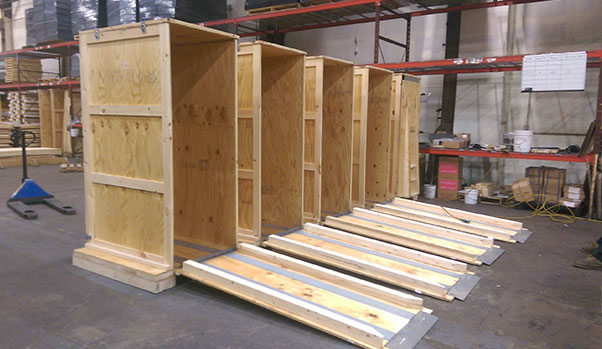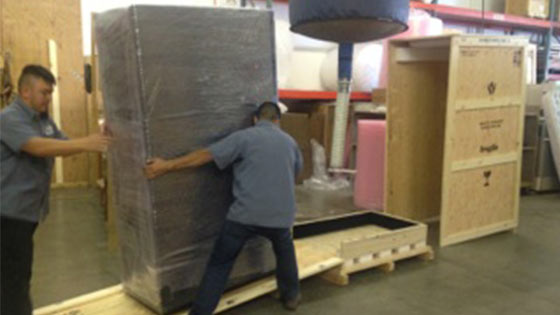It is rare to find a business today that doesn’t rely heavily on electronic equipment of some kind. This may include:
- Servers
- Personal computers
- Computer peripherals
- TVs
- Video conferencing equipment
- LCD and plasma monitors
- Telecommunications equipment
- Testing devices
- Laboratory equipment
- And many other types of equipment
And with businesses having to be agile and mobile in order to stay competitive, it is very common for them to ship sensitive electronics. In addition to these items being subject to damage if not handled properly, they tend also to be very expensive. In many ways, it is a “perfect storm” of risk.
How can you address that risk? A good first step is learning about the options available to you for shipping electronics safely.

How to Ensure Your Electronic Equipment Arrives in As-Shipped Condition
Your company has a large, expensive electronic device in Baltimore that is needed in your Seattle office. They require it as soon as possible—of course—and in a meeting about the project that calls for the device, all eyes look to you when the conversation shifts to shipping the item. The pressure is on!
Fortunately, you’ve read up on how to get sensitive electronics from Point A to Point B safely, and in a timely manner. So, you calmly provide information on eight key considerations for shipping this type of asset.
- You need to work with a company that has experience in specialty crating, packaging and shipping. Any shipper looking for work will tell you they can ship sensitive items safely. However, this type of project requires much more than simply putting a few more layers of wrap around the device or adding more packing peanuts to the box. If the company can’t tell you about several similar projects that they have completed successfully, you are taking a risk in going with them.
- Your item should be covered in a protective layer of anti-static wrap. In many cases, an electronic item isn’t damaged by things like being bounced around while in transit, but rather by a buildup of static electricity that subsequently damages its circuits or other components. Anti-static wrap can keep that buildup from occurring.
- Items being transported by ship need vapor-barrier bagging. Here again, often it isn’t a collision or crushing force that damages electronics, but something more subtle and frequently unseen: corrosion caused by high humidity. Sensitive items that will be exposed to salty ocean air in particular should be placed in a vapor-barrier bag along with an activated desiccant. The bag should then be heat sealed and have all the air inside removed with a specialized vacuum tool. What are called humidity indicator cards can also be placed in the bag before it is sealed so that the person receiving the shipment can see whether the item was exposed to high levels of humidity. There are also humidity indicator plugs that project through the vapor barrier and can be monitored during transport.
- Sensitive electronics should be shipped in a wood crate. Custom-designed wood crates offer maximum protection for fragile items. They may be crafted for a single use or, if you ship a particular type of item regularly, they can be designed to be reusable. For items that don’t need quite as much protection, strong, lightweight corrugated cardboard containers are a great option.
- If appropriate, items should be palletized. Securing an item to a strong wood pallet helps keep it stable and stationary during transport. There are different ways to ensure a piece of electronic equipment stays on a pallet, including wrapping it, banding it and other strategies.
- A floating deck should be used if appropriate. A floating deck is a base that is designed to absorb the shock and energy a crate receives during shipping. Floating decks can allow for various types of movement during transport: front-to-back, side-to-side, and up-and-down movement.
- Shock and tip sensors should be deployed if needed. These devices detect different types of forces affecting a shipping container or changes in its position so that you know whether it endured any concerning stresses during its travels. You might use this information to determine whether, for example, you need to run diagnostics on the piece of equipment before bringing it online.
- A ramp should be used for loading/unloading if appropriate. Sensitive electronics are subject to damage both before and after they complete their trek, as well. Moving an item into or out of a container, or the vehicle(s) that will be transporting the container, without due caution can lead to damage. Any transitions an item will make should be conducted carefully and smoothly, using a ramp or other assistive equipment as needed.
When you finish addressing the meeting attendees, they all nod their heads, confident that the item in question will get to its destination in great shape.

Expert Logistics: Smoothing the Way for Successful Shipping
One other important consideration for shipping sensitive electronics is that you should work with a specialty crating, packaging and shipping company that provides full logistical support. Anyone who has ever shipped business assets knows that it is not uncommon for shipments to get held up for one reason or another. Working with a shipping partner that knows how to anticipate problems, avoid them if possible and address them quickly and efficiently if they can’t be avoided is essential.
That ability only comes with many years of experience and a trusted network of contacts throughout the transportation ecosystem. The saying, “It’s not what you know but who you know,” certainly applies to the shipping business. For example, when your shipping company gets a “friendly heads-up” from a contact with the highway department about an upcoming road closure, it can help prevent delays and save you time and money in the process.
This is particularly true with international shipping. Getting business assets like electronics through customs can be challenging for shipping companies that are not familiar with the players, processes and paperwork.
How will you know if your specialty crating, packaging and shipping company can take the steps listed above and also provide outstanding logistical support? The best way to find out is to ask them. A company like Craters & Freighters that excels in these areas will be happy to describe their experience and expertise, as well as how they will deal with your electronic device specifically.

